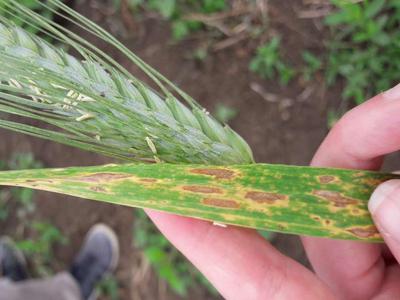Alternaria Leaf Blight
Alternaria triticina
Fungus
In a Nutshell
- The disease appears when wheat plants are 7-8 weeks old.
- The condition becomes severe when the crop is mature.
- Small, oval, discolored lesions can be found scattered on the leaves in an irregular manner.
- As the lesions enlarge, they become dark brown to grey and irregular in shape.
- The leaves eventually dry.
Can also be found in
Symptoms
Young plants are resistant to the pathogen. The lowermost leaves are always the first to show signs of infection, which gradually spreads to the upper leaves. Infection begins as small, oval, chlorotic lesions which are irregularly scattered on the lowermost leaves, gradually spreading to the upper leaves. Over time, the lesions enlarge, become irregular in shape and develop into dark brown or grey sunken lesions. Lesions may have a bright yellow marginal zone and can grow up to 1cm or more in diameter. Under moist conditions, lesions may be covered by black powdery conidia. At later stages of the disease, lesions will merge together resulting in the death of the entire leaf. In severe cases, leaf sheaths, awns and glumes are also affected and have a burnt appearance.
Recommendations

Organic Control
Seedborne infections can be controlled by treating seed with vitavax @ 2.5 per kg seed. A mixture of Trichoderma viride and vitavax effectively hinder further infections (by 98.4%). Mix Urea @ 2 - 3% with Zineb at first and second sprays. Apply aqueous Neem Leaf extracts. Fungicide and hot water treatments have been used to reduce seedborne inoculum. Pathogens Trichoderma viride (2%) and T. harzianum(2%), Aspergillus humicola and Bacillus subtilis are often used to control further outbreak of the disease.

Chemical Control
Always consider an integrated approach with preventive measures together with biological treatments, if available. A. triticina can be controlled through the application of fungicides with a 75% reduction in disease severity and an increase in plant yield. Apply fungicides such as mancozeb, ziram, zineb (0.2%), thiram, fytolan, propineb, chlorothalonil and nabam, propiconazole (0.15%), tebuconazole, and hexaconazole (0.5%). To prevent developing tolerance to mancozeb, apply a combination of fungicides.
What caused it?
Damage is caused by the fungus Alternaria triticina. Infection is both soilborne and seedborne and can be dispersed by wind. Infected seeds may be smaller than healthy ones and are often shriveled, with brown discoloration. Plants are affected when planted into infected soils or getting in contact with infested crop residues (e.g., by rain splashes or by direct contact). The fungus survives reportedly two months in infected debris on the soil surface during summer, but four months in buried debris. Susceptibility increases with plant age as A. triticina is unable to infect young wheat seedlings which are under about four weeks of age. The symptoms are usually not evident until the plants are about seven weeks of age. Temperatures of 20 - 25°C are optimal for infection and disease development. Under severe conditions, yield losses may exceed 80%.
Preventive Measures
- Use less-susceptible varieties as well as healthy seeds from certified sources.
- Practice the best hygiene measures.
- Infected crops should be destroyed by burning and ploughing.
- This will prevent aerial dispersal of the pathogen via infected crop residues.
- Herbicides can be used to destroy the infected crops.
- Infested fields should not be resown for a minimum of two years.
- Disposable equipment, infected plant material or soil should be disposed of by autoclaving, high-temperature incineration or deep burial.
- Any equipment removed from the site for disposal should be double-bagged.
- Deeply incorporate crop debris after harvest to reduce pathogen survival and primary inoculum that could incite future epidemics.
- Promote air movement within the canopy by planting rows parallel to prevailing wind direction, reducing plant population and planting on wider row spacing.
- Avoid irrigating near dusk and following overhead irrigation, if possible to reduce periods of leaf wetness.
- Apply adequate fertilizers.



